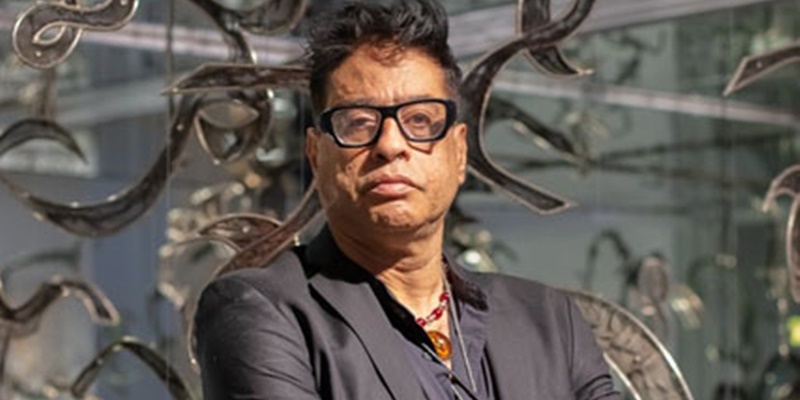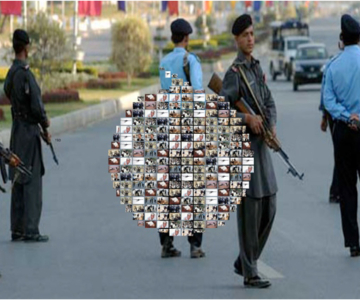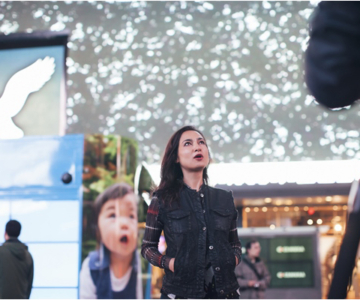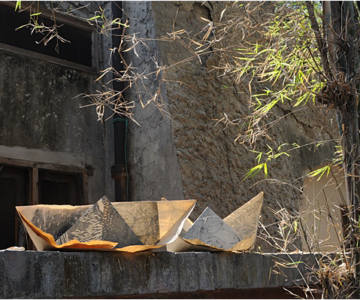Jahane Rumi is priveleged to publish this exclusive piece contributed by Syed Naveed Abbas
It is the month of December and one’s heart weeps as one invokes the memory of Guljee. His work is a living testament to our times and the dignity of a proud nation. He was the painter from the day he was born. A profoundly earnest and sincere artist, he displayed a high seriousness tempered with tenderness and a love of simplicity. Nevertheless, he is perhaps best known worldwide for his abstract work, which is inspired by Islamic calligraphy and is also influenced by the action painting. The images that Guljee’s brush strokes produced are not only rich in symbolic meaning but visually so much variegated that the eye travels fascinated from point to point. His painting comes from a divine inspiration, giving it a dimension of space and movement. He carried the script with a flourish in all directions, giving it the power of space, vigour and volume. He has made the brush prove mightier than the sword, time and again, and with his brush on canvas he has earned accolades. Whatever Guljee had a hand in turned out to have an unquenchable spark of utter genius.
His paintings are bright and full of colour, but the paint is put on with great sensitivity, and paintings vibrate with intense feeling. Areas sing with luminous, thin colour; thick blobs of paint pulsate with fiberglass tears, the brush swirls strong and free. The total effect is very free, yet considered and well thought out. They work enormously well, because it is all orchestrated with great care and concentration. His abstract paintings, produced since the 1960s, incorporate ornamental calligraphy, coloured beads, small pieces of mirror, and gold and silver leaf. These works include a large abstract mural painted in 1965 for the British engineering firm Wates Limited of London. In 1967 he began to make calligraphic sculptures in bronze, based on verses of the Koran, which were first exhibited in Tokyo in 1970. He made a large crescent and star in copper plate for the Faisal Mosque in Islamabad in 1986, and produced calligraphy in stone inside the mosque.
Ismail Guljee was born in Peshawar on October 25, 1926. His father and grandfather had moved there from Attock, while his mother was from Hazara. Guljee’s father studied at the Muslim College Peshawar. He was an engineer employed with the government and Guljee travelled with him a lot. His grandfather was a Sunday painter. Guljee first studied at Peshawar Convent School and then went to finish high school studies in Lawrence College situated in the Himalaya Mountains in a place called Ghora Galli near the British hill station called Murree. Guljee earned a scholarship for Aligarh University and then won the scholarship for the postgraduate studies at Columbia University. He studied engineering and later taught at Colombia.
There is some truth in the notion that the paintings are to the drawings as rhetoric is to reality. We tend to forget the extent to which great artist like Guljee saw more vividly and more personally then he painted. Ranging from quick sketches to large-scale works, these studies reveal the process by which Guljee created his lucid compositions and formulated the poses and expressions of individual figures. Earlier Guljee was more interested in portraits. Doing portraits becomes easier if you like the person, he says. On switching from portraits to calligraphy, he says that he uses the same colours. “I paint the whole day, from 11 am till around 8 pm. My brush moves like a quill. My earlier calligraphy was classical. In calligraphy you have to go back to your roots. I can write in any of the styles of the old masters. But I have given it a new direction”. Artists did not paint what they saw but what they wished to see or even what their patrons wished to see. Guljee has done portraits of Jinnah, King Khalid, King Faisal, King Fahd, Ayub Khan and Bhutto. Portraits are one of the few ways we can rediscover the freshness and spontaneity of the old masters. There is a quality to the best drawings which cannot be duplicated by any other medium. We could swear that some of the figures in the Guljee’s work actually seem to move.
Art icon Guljee’s works express his personality, upbringing, passion and the hard-times in his live. There is a dire need to take stock of Guljee’s works in private, public and corporate collections, and in different locations of the Pakistan Foreign Office and retrieve, restore and preserve them for future generations. He and his work were the subjects of unending analysis, esteem, adoration and mystery.
May his soul rest in peace!
The writer can be contacted via naveedabbas@gmail.com



